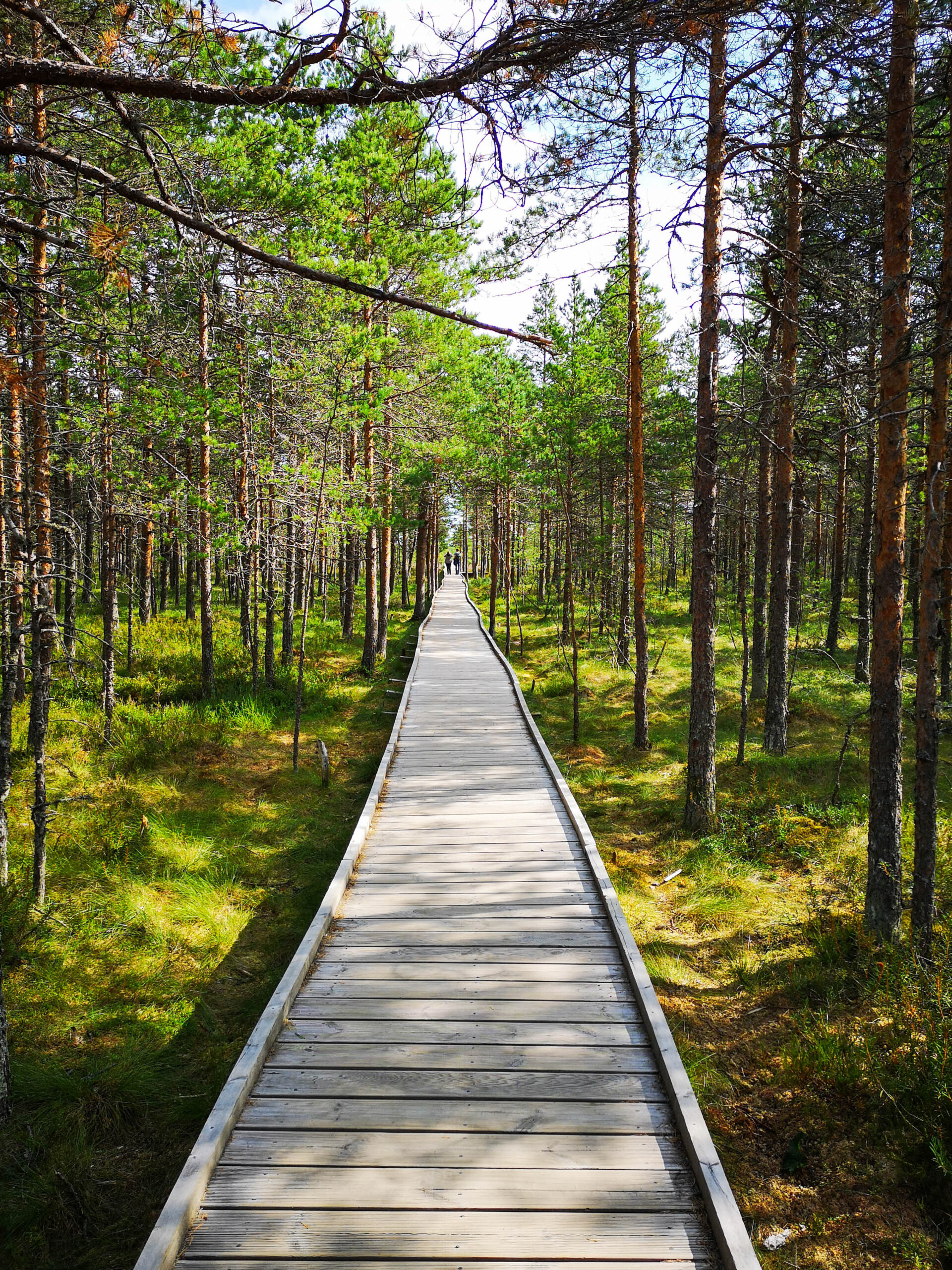Three very different and diverse wonderlands are located along a north-south axis in the neighbouring countries of Estonia and Latvia: Lahemaa and Soomaa National Parks in Estonia and Gauja National Park in Latvia. All are blessed with pristine nature, each in their own way.
Gems of Lahemaa include dry boreal forests, grand manorial estates, old fishermen’s villages and a unique submarine harbour.
The greatest assets of Soomaa National Park are its bogs, floodplain forests and wooded species rich meadows, and large-scale floods.
Gauja National Park, the largest in Latvia, is a treasure trove of different landscapes, diverse types of forests and it boasts a wealth of picturesque views to and from sandstone outcrops.
As seasons change, the national parks display an array of exceptional views from the land, water and air. Visitors have easy access to countless trails, whether on foot, bicycle, horseback or watercraft. Every taste will be catered for. Local culture and traditions are certainly worth experiencing and discovering.
Lahemaa National Park – Viru bog, submarines at Hara, manorial estates and a captains’ village
Upon arrival in Estonia, you could begin exploring the country in Lahemaa National Park on the northern coast. Lahemaa wins hearts with its lush forests, beautiful beaches and fishermen’s villages with their distinctive architecture. The National Park is crossed by several well-signposted long-distance hiking trails, such as the RMK Oandu-Ikla hiking trail and the Metsa hiking trail, which is part of the E11 international hiking trail. On the first you can stay overnight at campsites along the way, on the second you can find local accommodation at the end of a day’s hike.
There are several places where you can pitch a tent or spend the night in a lean-to shelter: e.g. Mustoja, Kalmeoja and Nõmmeveski. Campsites usually have a fire pit with a barbecue stand, dining tables, firewood and a dry toilet. All of this can be used free of charge in a responsible manner. The only thing to remember is that freedom to roam (everyman’s right) is applied – everyone has equal rights to stay and sleep there.
For a shorter walk, the hiking trail in Viru bog, just a 30-minute drive from Tallinn, is ideal. This walk in the bog alone is worth the trip to Lahemaa. The first part of the trail and the viewing tower can be easily reached in a wheelchair or with a pushchair. In total, the trail is six kilometres long, and it’s worth setting aside a couple of hours for a pleasant walk.
However, Lahemaa is not just a nature park. Several well-preserved manor complexes are a sight to savour. For example, Palmse Manor was first mentioned in the Middle Ages, when a King of Denmark donated a plot of land to St Michael’s nunnery of Tallinn. Nuns have never been seen here, and landlords have lived in imposing mansions for centuries. Today the estate in its wonderful settings is a museum where visitors can get a glimpse of luxurious lifestyle of the gentry in the mansion, palm house and lush gardens.
Hara Bay contains a rather unique sight in the Baltics – a submarine base within a military harbour built by the Soviet border guard.
From here you can set off on a tour of the military base, visit the island of Hara or the forests and coastal villages of the Juminda peninsula.
Should military heritage not be your cup of tea, a stone’s throw away is the Majakivi hiking trail, where you’ll find a huge boulder which is the third largest in Estonia. A ladder leads up to the top of the boulder (41 m of circumference), where you can admire the surrounding pine forest at the height of the canopy and why not do some yoga, write a travelogue entry or have a picnic while on top of the boulder. There are about a thousand boulder “giants” in Estonia, but only a few of them can be climbed up using a ladder. Another of these giants is located in the legendary captains’ village of Käsmu, right on the water’s edge.
Käsmu differs from other coastal villages by its more luxurious dwellings. Seafarers were once trained here, and many of them reached the rank of captain on the career ladder. Naturally, this meant a more handsome income, which was reflected in the opulence of the dwelling houses. Käsmu is a favourite summer holiday spot for many outstanding cultural figures. A visit to the Käsmu maritime museum completes a journey of discovery in Lahemaa.
Soomaa National Park – the fifth season, 10,000-year-old bogs and dugout boats
Established in 1993 in central Estonia, Soomaa National Park is characterised by huge marshlands and meandering shallow rivers between them, perfect for water trips. Bog and forest walking trails are a dream destination for those who want to experience unspoilt nature. The surroundings have a hypnotic effect and fairly quickly you lose track of time and the everyday rush.
The Soomaa region is the bottom of an ice lake formed by the retreat of the continental ice sheet some 10,000 years ago, with deposits that prevent water from draining through. As the ice and the lake receded, flat marshy areas remained, which over time became bogs. During the Soviet era, authorities intended turning bogs into farmland and built drainage systems in many places, which the Estonian state is now trying to revert into bogs again.
Soomaa got its name over 100 years ago from professor of geography Johannes Gabriel Granö who was the first to mention the area by that name. There are five major bogs in Soomaa. Kuresoo bog, the largest of the five, is also the largest marshland area in Estonia. You can take a walk of a few kilometres along Ingatsi study trail to a viewing tower and marvel at the fascinating views. To get to the bog, you even have to walk up some stairs, as the bog has risen more than ten metres over the millennia, whereas the forest has not. The bog continues rising at a rate of one millimetre per year.
You can travel by car or bike between the trails in Soomaa, as in many places a river cuts the path off. It is definitely worth taking a picnic basket and a towel with you to enjoy swimming in the bog lakes. In addition to the Ingatsi trail, you can also take a dip on the Riisa and Hüpassaare hiking trails.
Soomaa is one of those places that is much more than meets the eye. The most particular feature and magnet of this region is the floods, locally known as the fifth season. Floods are caused by high rainfall or melting snow in a short period of time, which means that the water can’t fit into the shallow riverbeds and floods the surrounding landscape. In some years, the floodwaters have risen up by a metre a day for three or four consecutive days.
In many places, there are signs of record flood levels. Standing on dry ground,it seems unfathomable that the water could be up to your chest and even nearby handrails may have been submerged at that place. Plant, animal and bird species and humans alike have adapted to the temporary high-water conditions.
The biggest floods in Soomaa occur in March-April, but they can strike at any time of the year when there is heavy rain. One thing is for sure, every fifth season has its own character. Then the whole of Soomaa will become a large waterway and lower roads will be submerged as well. Some local people need to resort to watercraft to reach neighbours or roads. On the other hand, canoeing, kayaking and SUP-boarding through forests and along meadows feels like being in the Amazon jungle. This natural wonder has made Soomaa famous the world over and is attracting more and more tourists from near and far.
Three shallow rivers – the Lemmjõgi, the Halliste and the Raudna – run through the park. Canoeing is a popular way of getting around here, even when the floods recede. In the old days, people used to make and ride a dugout canoe, which has become one of the symbols of the protected area. In Soomaa these were made from the aspen tree and boating was the only way to get around during floods. Of course, dugout canoeswere in use all year round, and used to go to the shop, school or delivering milk to a dairy. In 2021, the Soomaa dugout canoewas inscribed on the UNESCO World Heritage List.
In Soomaa, beavers are very much at home, and their activities can be followed on the fabulous Lemmjõe hiking trail and on the Beaver Trail at Tõramaa. The latter starts at the Soomaa Visitor Centre, where you can find more detailed information about hiking trails, local nature and sights, as well as washing and camping facilities.
Gauja National Park – wonderful landscapes and memorable settlements
Latvia’s largest, Gauja National Park is renowned for its primeval forests, sandstone outcrops and biodiversity. In the National Park, one natural wonder follows another, with almost 500 cultural and historical monuments: manors and castles, forts and fortresses, mills and churches, outstanding architecture and museums.
The National Park was established in 1973 and is named after the Gauja River, above which, with luck, kingfishers can be seen swooping. The area is ideal for leisure activities, hiking, cycling or canoeing.
If you should decide to visit the area, be prepared to encounter unspoilt nature, take a break from the fast-paced city life and challenge yourself on some wilderness trips.
The National Park stretches from Sigulda to Valmiera, and between them are Cesis, with its castle, and Ligatne, once home of the paper industry, both of which have a well-preserved history and, as you wander around, feel like one big museum.
In Sigulda, on the south-western edge of the Park, you can ride cable cars and bobsleighs on a track of which there are only 18 in the world. Thanks to the surrounding forests, Sigulda has been famous for centuries for its clean air and recreational opportunities. When you are there, find out what the locals are up to with their walking sticks. You’ll see these sticks both on city streets and in souvenir shops. If you’ve still got some stamina left, climb the tower of Turaida Castle (highly recommended in autumn!) and walk to the grave of Turaida Rose, of which local legend tells an unspeakably sad tale.
One of the trademarks of Gauja National Park are the nearly 350-million-year-old sandstone cliffs which come in a range of colours They contain caves as well as fascinating rock formations. The most prominent outcrops are the 22-metre-high Erglu Bank, which overlooks the Gauja valley, and the almost half-kilometre-long Sietiniezis Rock, which translates as “sieve rock”. Caves and pillars, niches and arches – there’s something to admire at every turn. What’s more, this wall is grey which is rather rare in sandstones. For recreation, there is a picnic area nearby, as well as a lean-to shelter and a swimming spot. So, pitch your tent and soak up as much peace and quiet as your soul desires.
In some very old forests, you can feel like in a fairy tale, where forest elves live among the moss-covered trees and ferns. In fact, forests cover almost half of the Park’s territory. 33 lakes and nearly 100 kilometres of the Gauja River also allow doing water sports as an alternative to walking and cycling.
Finishing your tour in the north of Gauja National Park, take a break at the Valmiermuiža Brewery, set up in an old manorial building, this is much more than just a place to taste hoppy beer. Here you’ll find handmade crafts from local artisans and tasty treats, and the air is thick with history.
But if you appreciate saunas and water treatments, step into the Ziedlejas nature spa, harmoniously tucked away in the countryside, where special rituals purify both body and soul.





